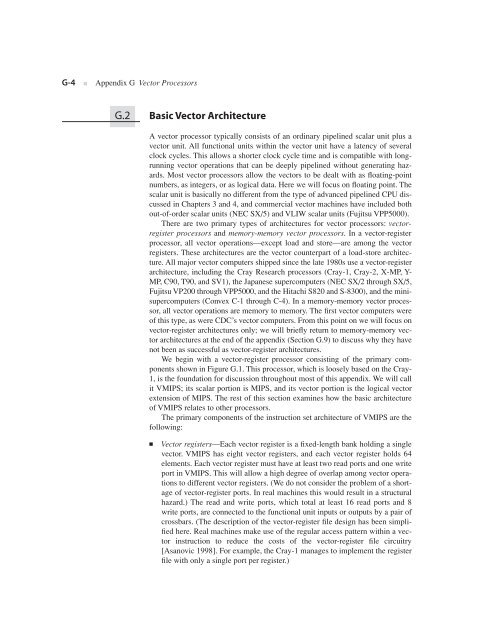Appendix G - Clemson University
Appendix G - Clemson University
Appendix G - Clemson University
Create successful ePaper yourself
Turn your PDF publications into a flip-book with our unique Google optimized e-Paper software.
G-4<br />
■<br />
<strong>Appendix</strong> G<br />
Vector Processors<br />
G.2 Basic Vector Architecture<br />
A vector processor typically consists of an ordinary pipelined scalar unit plus a<br />
vector unit. All functional units within the vector unit have a latency of several<br />
clock cycles. This allows a shorter clock cycle time and is compatible with longrunning<br />
vector operations that can be deeply pipelined without generating hazards.<br />
Most vector processors allow the vectors to be dealt with as floating-point<br />
numbers, as integers, or as logical data. Here we will focus on floating point. The<br />
scalar unit is basically no different from the type of advanced pipelined CPU discussed<br />
in Chapters 3 and 4, and commercial vector machines have included both<br />
out-of-order scalar units (NEC SX/5) and VLIW scalar units (Fujitsu VPP5000).<br />
There are two primary types of architectures for vector processors: vectorregister<br />
processors and memory-memory vector processors.<br />
In a vector-register<br />
processor, all vector operations—except load and store—are among the vector<br />
registers. These architectures are the vector counterpart of a load-store architecture.<br />
All major vector computers shipped since the late 1980s use a vector-register<br />
architecture, including the Cray Research processors (Cray-1, Cray-2, X-MP, Y-<br />
MP, C90, T90, and SV1), the Japanese supercomputers (NEC SX/2 through SX/5,<br />
Fujitsu VP200 through VPP5000, and the Hitachi S820 and S-8300), and the minisupercomputers<br />
(Convex C-1 through C-4). In a memory-memory vector processor,<br />
all vector operations are memory to memory. The first vector computers were<br />
of this type, as were CDC’s vector computers. From this point on we will focus on<br />
vector-register architectures only; we will briefly return to memory-memory vector<br />
architectures at the end of the appendix (Section G.9) to discuss why they have<br />
not been as successful as vector-register architectures.<br />
We begin with a vector-register processor consisting of the primary components<br />
shown in Figure G.1. This processor, which is loosely based on the Cray-<br />
1, is the foundation for discussion throughout most of this appendix. We will call<br />
it VMIPS; its scalar portion is MIPS, and its vector portion is the logical vector<br />
extension of MIPS. The rest of this section examines how the basic architecture<br />
of VMIPS relates to other processors.<br />
The primary components of the instruction set architecture of VMIPS are the<br />
following:<br />
■<br />
Vector registers—Each<br />
vector register is a fixed-length bank holding a single<br />
vector. VMIPS has eight vector registers, and each vector register holds 64<br />
elements. Each vector register must have at least two read ports and one write<br />
port in VMIPS. This will allow a high degree of overlap among vector operations<br />
to different vector registers. (We do not consider the problem of a shortage<br />
of vector-register ports. In real machines this would result in a structural<br />
hazard.) The read and write ports, which total at least 16 read ports and 8<br />
write ports, are connected to the functional unit inputs or outputs by a pair of<br />
crossbars. (The description of the vector-register file design has been simplified<br />
here. Real machines make use of the regular access pattern within a vector<br />
instruction to reduce the costs of the vector-register file circuitry<br />
[Asanovic 1998]. For example, the Cray-1 manages to implement the register<br />
file with only a single port per register.)

















